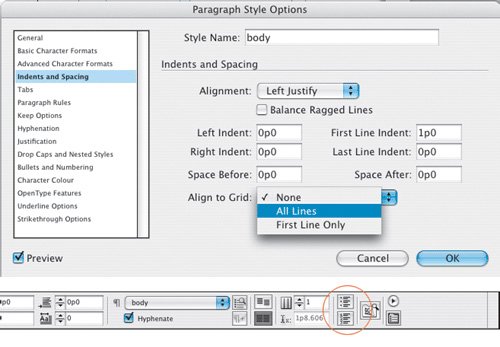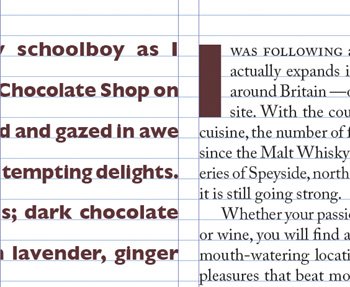Align to Grid
Once you've established a baseline grid, you can force your paragraphs to align to it by choosing All Lines. This option can be applied as part of a paragraph style definition, or can be applied locally using the Control palette.
Using a baseline grid is like setting a tempo for your document. In documents that use a variety of type and leading sizes, it's perfectly acceptable to go against that rhythm by coming off the grid with certain elements, such as headings and subheads, as long as the next passage of body text finds the beat again, and reestablishes the rhythm.
Figure 16.7. Align to Grid is usually applied as part of a paragraph style definition (top), but can also be applied locally using the Paragraph Formats level of the Control palette (bottom).

Aligning to the grid always means the next grid increment, causing leading values to be rounded up, never down. For example, if a paragraph with a specified leading value of 13 points is aligned to a 12-point grid, its leading will become 24 points.
For this reason, All Lines should be used only for body text and paragraph styles where the leading is already the same as the baseline grid increment.
Tip
When resizing graphics, the picture frame will snap to the baseline grid, making it easier to crop your picture frames to a leading increment. If you are using text wraps, set the text wrap offset to your leading increment.
If you've done the math right, choosing Align to Grid isn't strictly necessary. Your type will better align to the grid through careful planning and gentle persuasion than by coercion, because the total paragraph spacing applied to all your paragraphs is a multiple of your baseline grid increment. In practice, you'll probably find you need to add or subtract a bit of paragraph spacing here and there; this way, you, not InDesign, decide where the space is added or subtracted. The formula is simple: Total paragraph spacing (Leading + Space Before + Space After) must equal your leading increment or a multiple of your leading increment.
Let's say you're using a 12-point baseline grid and your body text is 10/12. The subheads are 18/18, making them 6 points off the grid. To put the subheads back on the grid, add 6 points of space before the subhead. Alternatively, you can add 4 points of space before and 2 points after.
First Line Only is useful for paragraphs such as multiline subheads or intro paragraphs that, because of their size and leading values, cannot keep to the grid. Nevertheless, you'll want to make sure that the first lines of such paragraphs align with the body text in adjacent columns. Subsequent lines will follow the specified leading increment.
Figure 16.8. The intro paragraph on the left aligns to First Line Only; the text on the right is set to All Lines.

First Baseline Options |
Part I: Character Formats
Getting Started
- Getting Started
- An InDesign Type Map: Where to Find Stuff
- Viewing Your Page
- Creating a Typography Workspace
- Up Next
Going with the Flow
- Going with the Flow
- A Blank Sheet: Typing on Your Page
- Text Flow
- Threading Text Frames
- Using Placeholder Text
- Pasting Text
- Importing Word Text
- Up Next
Character Reference
- Character Reference
- Less is More, Maybe
- Type Anatomy
- Type Classification
- Character Formatting Options
- Readability
- Up Next
Getting the Lead Out
- Getting the Lead Out
- How Much Is Enough?
- (Not) Using Auto Leading
- Keep It Consistent, Except. . .
- Leading Menu Options and Keyboard Shortcuts
- See Also
- Up Next
Kern, Baby, Kern
- Kern, Baby, Kern
- When to Kern
- Metrics Kerning
- Optical Kerning
- Manual Kerning
- How Much to Kern
- Tracking
- When to Track
- Controlling Widows and Orphans
- Up Next
Sweating the Small Stuff: Special Characters, White Space, and Glyphs
- Sweating the Small Stuff: Special Characters, White Space, and Glyphs
- Typographers Quotes
- Apostrophes
- Dashes
- Ellipses
- End Marks
- White Space Characters
- The Glyphs Palette
- Footnotes
- Footnote Options
- Up Next
OpenType: The New Frontier in Font Technology
- OpenType: The New Frontier in Font Technology
- Ligatures
- Discretionary Ligatures
- Ordinals/Raised and Lowered Characters
- Swash Characters
- Fractions
- Oldstyle Figures
- Contextual Alternates
- Opticals
- Glyph Positioning
- Stylistic Sets
- Up Next
Part II: Paragraph Formats
Aligning Your Type
- Aligning Your Type
- Centering Type
- Clean Shaven or Rugged: Justified vs. Ragged Type
- How InDesign Justifies Type
- Balancing Ragged Lines
- Right-Aligned Type
- Optical Margin Alignment
- Indent to Here
- Vertical Alignment
- Up Next
Paragraph Indents and Spacing
First Impressions: Creating Great Opening Paragraphs
- First Impressions: Creating Great Opening Paragraphs
- Creating a Simple Drop Cap
- Drop Cap Aesthetics
- Tricks with Drop Caps
- Up Next
Dont Fear the Hyphen
Mastering Tabs and Tables
- Mastering Tabs and Tables
- Setting Tabs
- Creating Decimal Tabs
- Using Tab Leaders
- Reply Forms
- Numbered Lists
- Right Indent Tab
- Working with Tables
- Creating a Table
- Working with Rows and Columns
- Working with Table Cells
- Up Next
Part III: Styles
Stylin with Paragraph and Character Styles
- Stylin with Paragraph and Character Styles
- Creating Styles
- Applying Styles
- Editing Styles
- Redefining Styles
- Creating Default Styles
- A Typical Style Sheet
- Up Next
Mo Style
Part IV: Page Layout
Setting Up Your Document
- Setting Up Your Document
- Choosing a Page Size
- Determining Margins
- Determining Column Width
- Changing Columns
- Break Characters
- Page Numbers
- Section Markers
- Up Next
Everything in Its Right Place: Using Grids
- Everything in Its Right Place: Using Grids
- Things to Consider
- Your Grid Tool Kit
- Calculating the Height of the Type Area
- Align to Grid
- First Baseline Options
- Snap to Guides
- Up Next
Text Wraps: The Good, the Bad, and the Ugly
- Text Wraps: The Good, the Bad, and the Ugly
- Applying Text Wraps
- Wrapping Type Around Irregularly Shaped Graphics
- Text Wrap Preferences
- Ignoring Text Wrap
- Anchored Objects
- Up Next
Type Effects
EAN: 2147483647
Pages: 186
